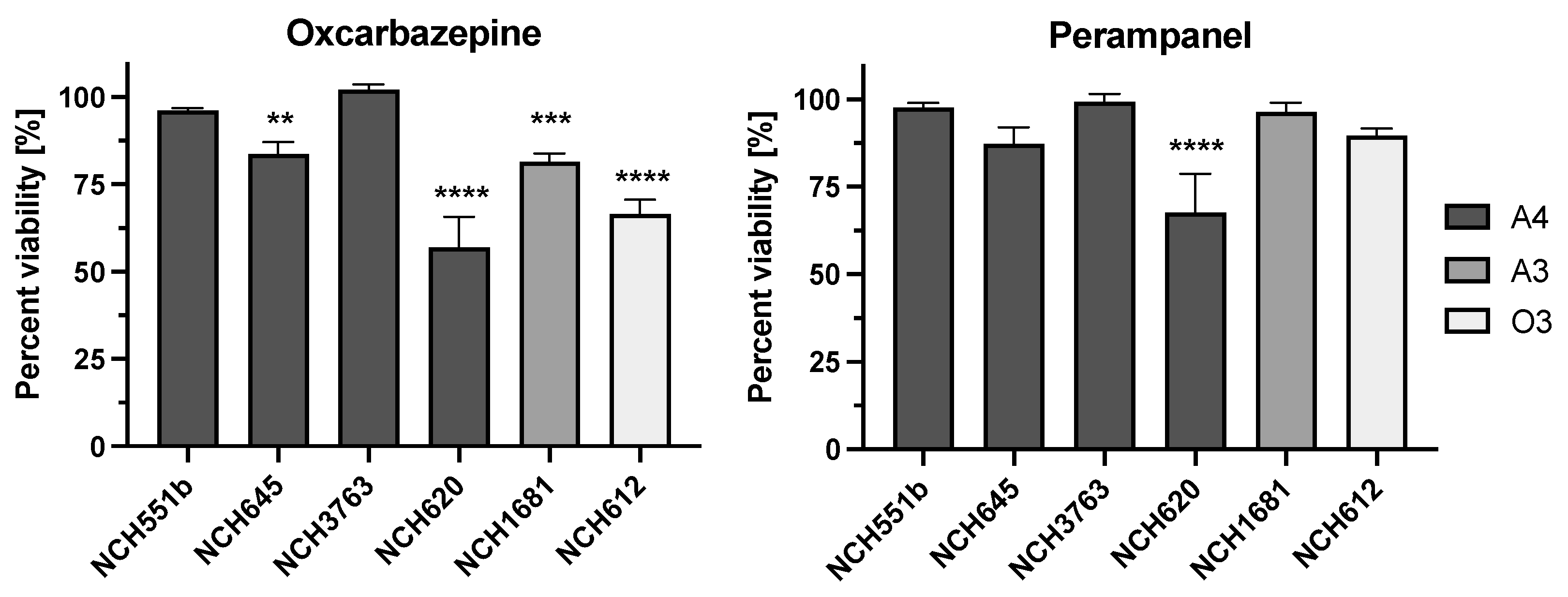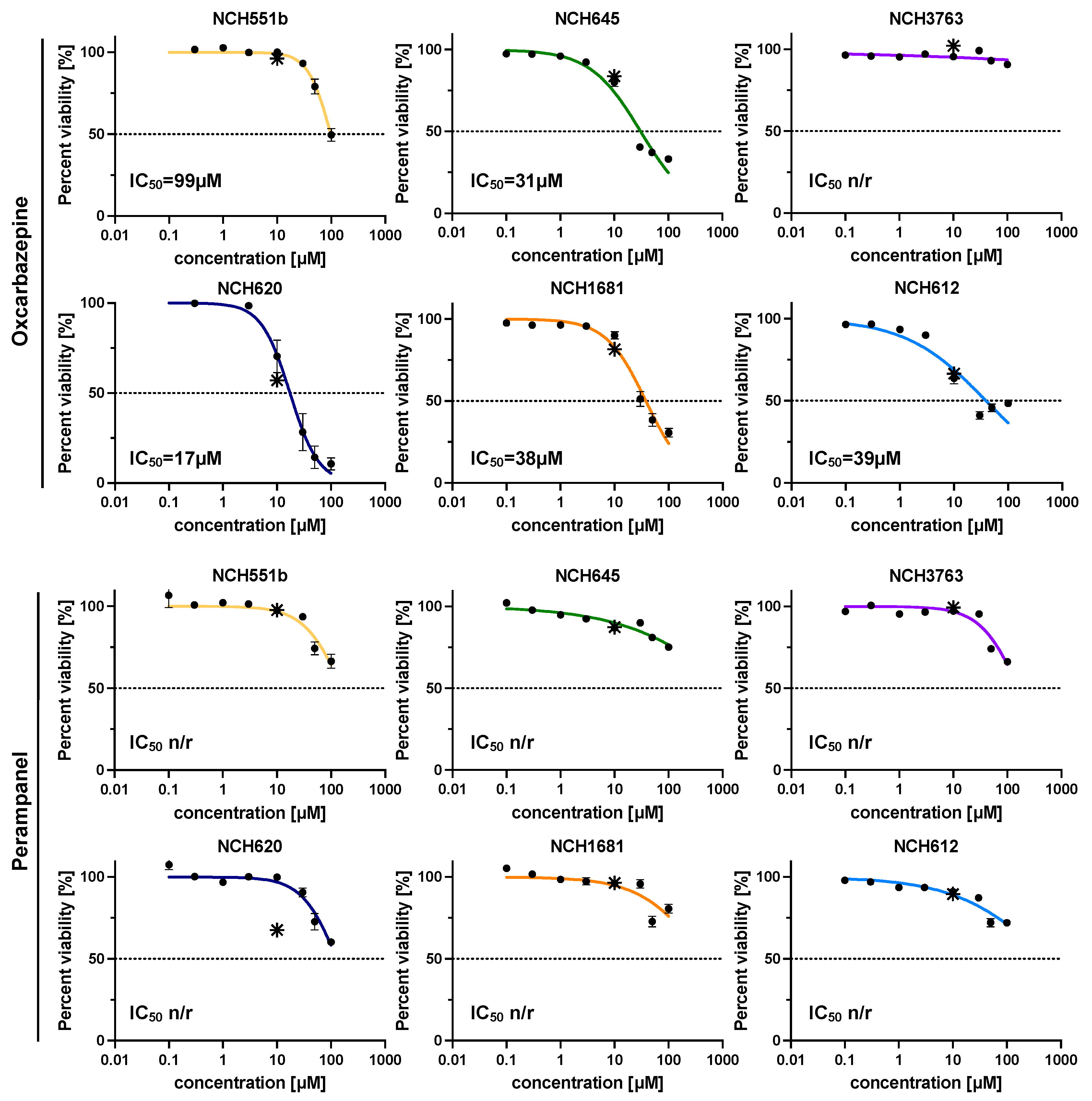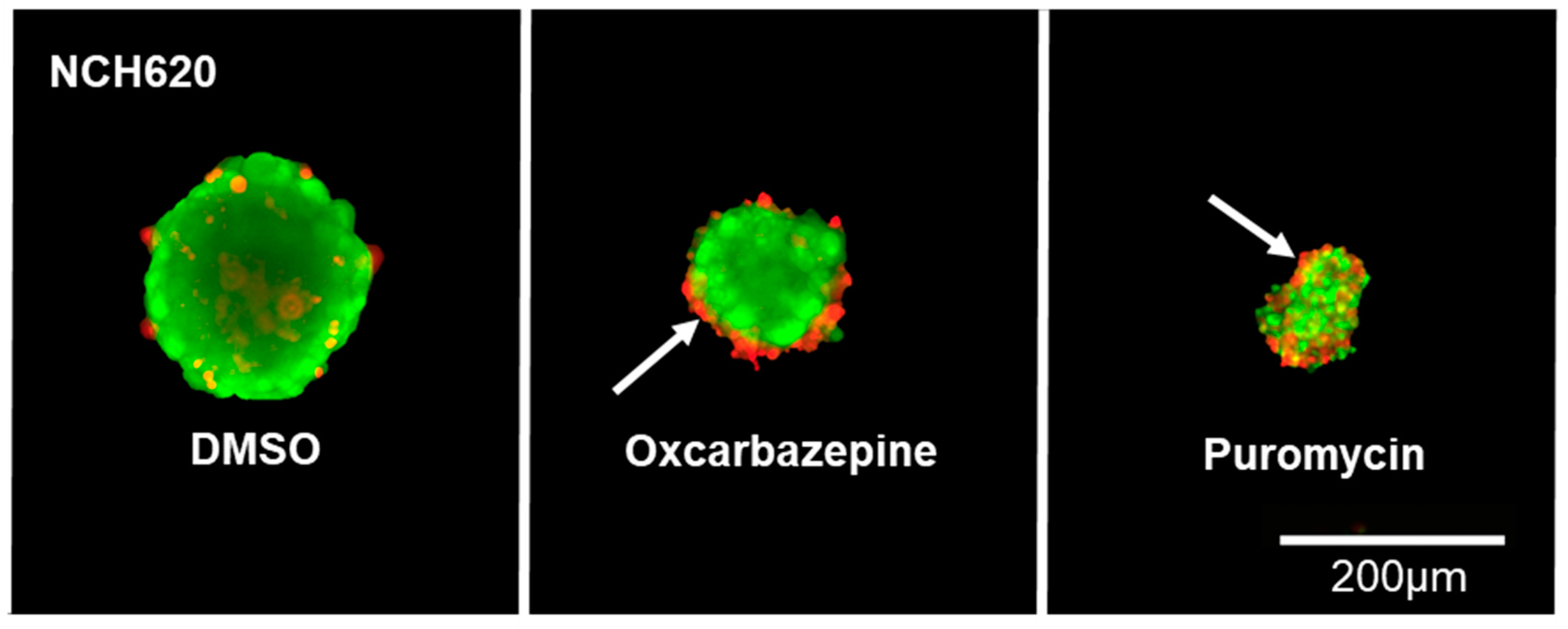The Antiepileptic Drug Oxcarbazepine Inhibits the Growth of Patient-Derived Isocitrate Dehydrogenase Mutant Glioma Stem-like Cells
Abstract
Simple Summary
Abstract
1. Introduction
2. Materials and Methods
2.1. Cell Culture and Antiepileptic Drug Selection
2.2. Cell Proliferation and Viability
2.3. Fluorescence Imaging
2.4. Apoptosis Assay
2.5. Statistical Analysis
3. Results
3.1. Antiproliferative Effect of AEDs in IDHmut Glioma Stem-like Cells
3.2. Dose-Dependent Growth Inhibtion by Oxcarbazepine and Perampanel
3.3. Proapoptotic Effect of Oxcarbazepine
4. Discussion
5. Conclusions
Supplementary Materials
Author Contributions
Funding
Institutional Review Board Statement
Informed Consent Statement
Data Availability Statement
Acknowledgments
Conflicts of Interest
References
- Chen, H.; Judkins, J.; Thomas, C.; Wu, M.; Khoury, L.; Benjamin, C.G.; Pacione, D.; Golfinos, J.G.; Kumthekar, P.; Ghamsari, F.; et al. Mutant IDH1 and Seizures in Patients with Glioma. Neurology 2017, 88, 1805–1813. [Google Scholar] [CrossRef][Green Version]
- Avila, E.K.; Chamberlain, M.; Schiff, D.; Reijneveld, J.C.; Armstrong, T.S.; Ruda, R.; Wen, P.Y.; Weller, M.; Koekkoek, J.A.F.; Mittal, S.; et al. Seizure Control as a New Metric in Assessing Efficacy of Tumor Treatment in Low-Grade Glioma Trials. Neuro Oncol. 2017, 19, 12–21. [Google Scholar] [CrossRef] [PubMed][Green Version]
- Klein, M.; Engelberts, N.H.J.; van der Ploeg, H.M.; Kasteleijn-Nolst Trenité, D.G.A.; Aaronson, N.K.; Taphoorn, M.J.B.; Baaijen, H.; Vandertop, W.P.; Muller, M.; Postma, T.J.; et al. Epilepsy in Low-Grade Gliomas: The Impact on Cognitive Function and Quality of Life. Ann. Neurol. 2003, 54, 514–520. [Google Scholar] [CrossRef] [PubMed]
- Englot, D.J.; Han, S.J.; Berger, M.S.; Barbaro, N.M.; Chang, E.F. Extent of Surgical Resection Predicts Seizure Freedom in Low-Grade Temporal Lobe Brain Tumors. Neurosurgery 2012, 70, 921–928. [Google Scholar] [CrossRef] [PubMed]
- Kim, J.; Radjadurai, S.; Rahman, Z.; Hitos, K.; Ghattas, S.; Gomes, L.; Wong, C.; Bleasel, A.; Dexter, M.A. Outcomes of Tumour Related Epilepsy in a Specialised Epilepsy Surgery Unit. J. Clin. Neurosci. 2019, 59, 265–269. [Google Scholar] [CrossRef]
- Sherman, J.H.; Moldovan, K.; Yeoh, H.K.; Starke, R.M.; Pouratian, N.; Shaffrey, M.E.; Schiff, D. Impact of Temozolomide Chemotherapy on Seizure Frequency in Patients with Low-Grade Gliomas. J. Neurosurg. 2011, 114, 1617–1621. [Google Scholar] [CrossRef]
- van den Bent, M.J.; Afra, D.; de Witte, O.; Ben Hassel, M.; Schraub, S.; Hoang-Xuan, K.; Malmström, P.-O.; Collette, L.; Piérart, M.; Mirimanoff, R.; et al. Long-Term Efficacy of Early versus Delayed Radiotherapy for Low-Grade Astrocytoma and Oligodendroglioma in Adults: The EORTC 22845 Randomised Trial. Lancet 2005, 366, 985–990. [Google Scholar] [CrossRef]
- Venkataramani, V.; Tanev, D.I.; Strahle, C.; Studier-Fischer, A.; Fankhauser, L.; Kessler, T.; Körber, C.; Kardorff, M.; Ratliff, M.; Xie, R.; et al. Glutamatergic Synaptic Input to Glioma Cells Drives Brain Tumour Progression. Nature 2019, 573, 532–538. [Google Scholar] [CrossRef]
- Venkatesh, H.S.; Morishita, W.; Geraghty, A.C.; Silverbush, D.; Gillespie, S.M.; Arzt, M.; Tam, L.T.; Espenel, C.; Ponnuswami, A.; Ni, L.; et al. Electrical and Synaptic Integration of Glioma into Neural Circuits. Nature 2019, 573, 539–545. [Google Scholar] [CrossRef]
- Pan, C.; Winkler, F. Insights and Opportunities at the Crossroads of Cancer and Neuroscience. Nat. Cell. Biol. 2022, 24, 1454–1460. [Google Scholar] [CrossRef]
- Pusch, S.; Krausert, S.; Fischer, V.; Balss, J.; Ott, M.; Schrimpf, D.; Capper, D.; Sahm, F.; Eisel, J.; Beck, A.-C.; et al. Pan-Mutant IDH1 Inhibitor BAY 1436032 for Effective Treatment of IDH1 Mutant Astrocytoma In Vivo. Acta Neuropathol. 2017, 133, 629–644. [Google Scholar] [CrossRef] [PubMed]
- Dettling, S.; Stamova, S.; Warta, R.; Schnölzer, M.; Rapp, C.; Rathinasamy, A.; Reuss, D.; Pocha, K.; Roesch, S.; Jungk, C.; et al. Identification of CRKII, CFL1, CNTN1, NME2, and TKT as Novel and Frequent T-Cell Targets in Human IDH-Mutant Glioma. Clin. Cancer Res. 2018, 24, 2951–2962. [Google Scholar] [CrossRef] [PubMed][Green Version]
- Dao Trong, P.; Jungwirth, G.; Yu, T.; Pusch, S.; Unterberg, A.; Herold-Mende, C.; Warta, R. Large-Scale Drug Screening in Patient-Derived IDHmut Glioma Stem Cells Identifies Several Efficient Drugs among FDA-Approved Antineoplastic Agents. Cells 2020, 9, 1389. [Google Scholar] [CrossRef] [PubMed]
- Campos, B.; Wan, F.; Farhadi, M.; Ernst, A.; Zeppernick, F.; Tagscherer, K.E.; Ahmadi, R.; Lohr, J.; Dictus, C.; Gdynia, G.; et al. Differentiation Therapy Exerts Antitumor Effects on Stem-like Glioma Cells. Clin. Cancer Res. 2010, 16, 2715–2728. [Google Scholar] [CrossRef] [PubMed][Green Version]
- Kohanbash, G.; Carrera, D.A.; Shrivastav, S.; Ahn, B.J.; Jahan, N.; Mazor, T.; Chheda, Z.S.; Downey, K.M.; Watchmaker, P.B.; Beppler, C.; et al. Isocitrate Dehydrogenase Mutations Suppress STAT1 and CD8+ T Cell Accumulation in Gliomas. J. Clin. Invest. 2017, 127, 1425–1437. [Google Scholar] [CrossRef]
- Antunes, N.d.J.; Wichert-Ana, L.; Coelho, E.B.; Della Pasqua, O.; Alexandre Junior, V.; Takayanagui, O.M.; Marques, M.P.; Lanchote, V.L. Analysis of Unbound Plasma Concentration of Oxcarbazepine and the 10-Hydroxycarbazepine Enantiomers by Liquid Chromatography with Tandem Mass Spectrometry in Healthy Volunteers. J. Pharm. Biomed. Anal. 2018, 149, 442–447. [Google Scholar] [CrossRef]
- Uhlén, M.; Fagerberg, L.; Hallström, B.M.; Lindskog, C.; Oksvold, P.; Mardinoglu, A.; Sivertsson, Å.; Kampf, C.; Sjöstedt, E.; Asplund, A.; et al. Tissue-Based Map of the Human Proteome. Science 2015, 347, 1260419. [Google Scholar] [CrossRef]
- Li, Y.; Shan, X.; Wu, Z.; Wang, Y.; Ling, M.; Fan, X. IDH1 Mutation Is Associated with a Higher Preoperative Seizure Incidence in Low-Grade Glioma: A Systematic Review and Meta-Analysis. Seizure 2018, 55, 76–82. [Google Scholar] [CrossRef][Green Version]
- Gefroh-Grimes, H.A.; Gidal, B.E. Antiepileptic Drugs in Patients with Malignant Brain Tumor: Beyond Seizures and Pharmacokinetics. Acta Neurol. Scand. 2016, 133, 4–16. [Google Scholar] [CrossRef]
- Waitkus, M.S.; Diplas, B.H.; Yan, H. Biological Role and Therapeutic Potential of IDH Mutations in Cancer. Cancer Cell 2018, 34, 186–195. [Google Scholar] [CrossRef][Green Version]
- Bunse, L.; Pusch, S.; Bunse, T.; Sahm, F.; Sanghvi, K.; Friedrich, M.; Alansary, D.; Sonner, J.K.; Green, E.; Deumelandt, K.; et al. Suppression of Antitumor T Cell Immunity by the Oncometabolite (R)-2-Hydroxyglutarate. Nat. Med. 2018, 24, 1192–1203. [Google Scholar] [CrossRef] [PubMed]
- Patsalos, P.N.; Berry, D.J.; Bourgeois, B.F.D.; Cloyd, J.C.; Glauser, T.A.; Johannessen, S.I.; Leppik, I.E.; Tomson, T.; Perucca, E. Antiepileptic Drugs—Best Practice Guidelines for Therapeutic Drug Monitoring: A Position Paper by the Subcommission on Therapeutic Drug Monitoring, ILAE Commission on Therapeutic Strategies. Epilepsia 2008, 49, 1239–1276. [Google Scholar] [CrossRef] [PubMed]
- de Bruin, M.E.; van der Meer, P.B.; Dirven, L.; Taphoorn, M.J.B.; Koekkoek, J.A.F. Efficacy of Antiepileptic Drugs in Glioma Patients with Epilepsy: A Systematic Review. Neurooncol. Pract. 2021, 8, 501–517. [Google Scholar] [CrossRef] [PubMed]
- Vecht, C.J.; Kerkhof, M.; Duran-Pena, A. Seizure Prognosis in Brain Tumors: New Insights and Evidence-Based Management. Oncologist 2014, 19, 751–759. [Google Scholar] [CrossRef] [PubMed][Green Version]
- van der Meer, P.B.; Dirven, L.; Fiocco, M.; Vos, M.J.; Kouwenhoven, M.C.M.; van den Bent, M.J.; Taphoorn, M.J.B.; Koekkoek, J.A.F. First-Line Antiepileptic Drug Treatment in Glioma Patients with Epilepsy: Levetiracetam vs Valproic Acid. Epilepsia 2021, 62, 1119–1129. [Google Scholar] [CrossRef] [PubMed]
- Sills, G.J.; Rogawski, M.A. Mechanisms of Action of Currently Used Antiseizure Drugs. Neuropharmacology 2020, 168, 107966. [Google Scholar] [CrossRef] [PubMed]
- Kamarudin, M.N.A.; Parhar, I. Emerging Therapeutic Potential of Anti-Psychotic Drugs in the Management of Human Glioma: A Comprehensive Review. Oncotarget 2019, 10, 3952–3977. [Google Scholar] [CrossRef][Green Version]
- Göttlicher, M.; Minucci, S.; Zhu, P.; Krämer, O.H.; Schimpf, A.; Giavara, S.; Sleeman, J.P.; Lo Coco, F.; Nervi, C.; Pelicci, P.G.; et al. Valproic Acid Defines a Novel Class of HDAC Inhibitors Inducing Differentiation of Transformed Cells. EMBO J. 2001, 20, 6969–6978. [Google Scholar] [CrossRef][Green Version]
- Knüpfer, M.M.; Hernáiz-Driever, P.; Poppenborg, H.; Wolff, J.E.; Cinatl, J. Valproic Acid Inhibits Proliferation and Changes Expression of CD44 and CD56 of Malignant Glioma Cells in Vitro. Anticancer Res. 1998, 18, 3585–3589. [Google Scholar]
- Riva, G.; Butta, V.; Cilibrasi, C.; Baronchelli, S.; Redaelli, S.; Dalprà, L.; Lavitrano, M.; Bentivegna, A. Epigenetic Targeting of Glioma Stem Cells: Short-Term and Long-Term Treatments with Valproic Acid Modulate DNA Methylation and Differentiation Behavior, but Not Temozolomide Sensitivity. Oncol. Rep. 2016, 35, 2811–2824. [Google Scholar] [CrossRef][Green Version]
- Kerkhof, M.; Dielemans, J.C.M.; van Breemen, M.S.; Zwinkels, H.; Walchenbach, R.; Taphoorn, M.J.; Vecht, C.J. Effect of Valproic Acid on Seizure Control and on Survival in Patients with Glioblastoma Multiforme. Neuro Oncol. 2013, 15, 961–967. [Google Scholar] [CrossRef] [PubMed][Green Version]
- Cacho-Diaz, B.; San-Juan, D.; Salmeron, K.; Boyzo, C.; Lorenzana-Mendoza, N. Choice of Antiepileptic Drugs Affects the Outcome in Cancer Patients with Seizures. Clin. Transl. Oncol. 2018, 20, 1571–1576. [Google Scholar] [CrossRef] [PubMed]
- Knudsen-Baas, K.M.; Engeland, A.; Gilhus, N.E.; Storstein, A.M.; Owe, J.F. Does the Choice of Antiepileptic Drug Affect Survival in Glioblastoma Patients? J. Neurooncol. 2016, 129, 461–469. [Google Scholar] [CrossRef] [PubMed][Green Version]
- Happold, C.; Gorlia, T.; Chinot, O.; Gilbert, M.R.; Nabors, L.B.; Wick, W.; Pugh, S.L.; Hegi, M.; Cloughesy, T.; Roth, P.; et al. Does Valproic Acid or Levetiracetam Improve Survival in Glioblastoma? A Pooled Analysis of Prospective Clinical Trials in Newly Diagnosed Glioblastoma. JCO 2016, 34, 731–739. [Google Scholar] [CrossRef]
- Redjal, N.; Reinshagen, C.; Le, A.; Walcott, B.P.; McDonnell, E.; Dietrich, J.; Nahed, B.V. Valproic Acid, Compared to Other Antiepileptic Drugs, Is Associated with Improved Overall and Progression-Free Survival in Glioblastoma but Worse Outcome in Grade II/III Gliomas Treated with Temozolomide. J. Neurooncol. 2016, 127, 505–514. [Google Scholar] [CrossRef]
- Weller, M.; Gorlia, T.; Cairncross, J.G.; van den Bent, M.J.; Mason, W.; Belanger, K.; Brandes, A.A.; Bogdahn, U.; Macdonald, D.R.; Forsyth, P.; et al. Prolonged Survival with Valproic Acid Use in the EORTC/NCIC Temozolomide Trial for Glioblastoma. Neurology 2011, 77, 1156–1164. [Google Scholar] [CrossRef][Green Version]
- Quilichini, P.P.; Chiron, C.; Ben-Ari, Y.; Gozlan, H. Stiripentol, a Putative Antiepileptic Drug, Enhances the Duration of Opening of GABA-A Receptor Channels. Epilepsia 2006, 47, 704–716. [Google Scholar] [CrossRef]
- Hibi, S.; Ueno, K.; Nagato, S.; Kawano, K.; Ito, K.; Norimine, Y.; Takenaka, O.; Hanada, T.; Yonaga, M. Discovery of 2-(2-Oxo-1-Phenyl-5-Pyridin-2-Yl-1,2-Dihydropyridin-3-Yl)Benzonitrile (Perampanel): A Novel, Noncompetitive α-Amino-3-Hydroxy-5-Methyl-4-Isoxazolepropanoic Acid (AMPA) Receptor Antagonist. J. Med. Chem. 2012, 55, 10584–10600. [Google Scholar] [CrossRef]
- Lynch, B.A.; Lambeng, N.; Nocka, K.; Kensel-Hammes, P.; Bajjalieh, S.M.; Matagne, A.; Fuks, B. The Synaptic Vesicle Protein SV2A Is the Binding Site for the Antiepileptic Drug Levetiracetam. Proc. Natl. Acad. Sci. USA 2004, 101, 9861–9866. [Google Scholar] [CrossRef][Green Version]
- Glauser, T.; Ben-Menachem, E.; Bourgeois, B.; Cnaan, A.; Guerreiro, C.; Kälviäinen, R.; Mattson, R.; French, J.A.; Perucca, E.; Tomson, T.; et al. Updated ILAE Evidence Review of Antiepileptic Drug Efficacy and Effectiveness as Initial Monotherapy for Epileptic Seizures and Syndromes. Epilepsia 2013, 54, 551–563. [Google Scholar] [CrossRef]
- Johannessen, S.I.; Tomson, T. Pharmacokinetic Variability of Newer Antiepileptic Drugs: When Is Monitoring Needed? Clin. Pharm. 2006, 45, 1061–1075. [Google Scholar] [CrossRef] [PubMed]
- Jacob, S.; Nair, A.B. An Updated Overview on Therapeutic Drug Monitoring of Recent Antiepileptic Drugs. Drugs RD 2016, 16, 303–316. [Google Scholar] [CrossRef] [PubMed][Green Version]
- Reimers, A.; Berg, J.A.; Burns, M.L.; Brodtkorb, E.; Johannessen, S.I.; Landmark, C.J. Reference Ranges for Antiepileptic Drugs Revisited: A Practical Approach to Establish National Guidelines. DDDT 2018, 12, 271–280. [Google Scholar] [CrossRef][Green Version]
- Schmutz, M.; Brugger, F.; Gentsch, C.; McLean, M.J.; Olpe, H.R. Oxcarbazepine: Preclinical Anticonvulsant Profile and Putative Mechanisms of Action. Epilepsia 1994, 35 (Suppl. 5), S47–S50. [Google Scholar] [CrossRef]
- Malátková, P.; Havlíková, L.; Wsól, V. The Role of Carbonyl Reducing Enzymes in Oxcarbazepine in Vitro Metabolism in Man. Chem. Biol. Interact. 2014, 220, 241–247. [Google Scholar] [CrossRef]
- González-Esquivel, D.F.; Ortega-Gavilán, M.; Alcántara-López, G.; Jung-Cook, H. Plasma Level Monitoring of Oxcarbazepine in Epileptic Patients. Arch. Med. Res. 2000, 31, 202–205. [Google Scholar] [CrossRef]
- Lee, C.-Y.; Lai, H.-Y.; Chiu, A.; Chan, S.-H.; Hsiao, L.-P.; Lee, S.-T. The Effects of Antiepileptic Drugs on the Growth of Glioblastoma Cell Lines. J. Neurooncol. 2016, 127, 445–453. [Google Scholar] [CrossRef][Green Version]
- Kim, D.W.; Gu, N.; Jang, I.-J.; Chu, K.; Yu, K.-S.; Cho, J.-Y.; Yoon, S.H.; Kim, H.S.; Oh, J.; Lee, S.K. Efficacy, Tolerability, and Pharmacokinetics of Oxcarbazepine Oral Loading in Patients with Epilepsy. Epilepsia 2012, 53, e9–e12. [Google Scholar] [CrossRef]
- Lange, F.; Weßlau, K.; Porath, K.; Hörnschemeyer, J.; Bergner, C.; Krause, B.J.; Mullins, C.S.; Linnebacher, M.; Köhling, R.; Kirschstein, T. AMPA Receptor Antagonist Perampanel Affects Glioblastoma Cell Growth and Glutamate Release in Vitro. PLoS ONE 2019, 14, e0211644. [Google Scholar] [CrossRef][Green Version]
- Mayer, J.; Kirschstein, T.; Resch, T.; Porath, K.; Krause, B.J.; Köhling, R.; Lange, F. Perampanel Attenuates Epileptiform Phenotype in C6 Glioma. Neurosci. Lett. 2020, 715, 134629. [Google Scholar] [CrossRef]





| GSCs | Diagnosis | IDH Mutation | Gender | TAE |
|---|---|---|---|---|
| NCH612 | rOligo WHO grade 3 | IDH mutated # | m | yes |
| NCH1681 | rAstro WHO grade 3 | IDH1 (R132H) * | f | yes |
| NCH551b | rAstro WHO grade 4 | IDH1 (R132H) * | m | yes |
| NCH620 | rAstro WHO grade 4 | IDH1 (R132H) * | f | yes |
| NCH645 | rAstro WHO grade 4 | IDH1 (R132H) * | m | no |
| NCH3763 | rAstro WHO grade 4 | IDH1 (R132H) * | m | yes |
| Mode of Action | Usage | Therapeutic Reference Range [41,42,43] | ||||||||||||
|---|---|---|---|---|---|---|---|---|---|---|---|---|---|---|
| Na+ Channel | Ca2+ Channel | GABAa Rec. Modidifier | Modul. of GABA Disposition | Ca2+ Dependent K+ Channel | CA Inhibitor | AMPA Receptor | Kainate Receptor | SV2A Vesicle Binding | HDAC Inhibitor | Efficacy in Glioma [23] | Adults with Partial Onset Seizures [40] | µg/mL | µM | |
| Phenytoin | +++ | *** | Level A | 10–20 | 40–80 | |||||||||
| Carbamazepine | +++ | ** | Level A | 4–11 | 15–45 | |||||||||
| Eslicarbazepine | ++ | 3–26 | 12–100 | |||||||||||
| Rufinamide | ++ | 4–31 | 15–130 | |||||||||||
| Lacosamide | ++ | + | ** | 3–10 | 10–40 | |||||||||
| Oxcarbazepine a | ++ | ++ | + | ** | Level C | 3–36 | 12–140 | |||||||
| Lamotrigine | ++ | +++ | Level C | 3–13 | 10–50 | |||||||||
| Zonisamide | + | + | + | Level A | 10–38 | 45–180 | ||||||||
| Ethosuximide | + | + | + | 39–99 | 280–700 | |||||||||
| Felbamate | + | + | + | 30–60 | 125–250 | |||||||||
| Topiramate | + | + | + | + | ++ | ** | Level C | 2–10 | 6–30 | |||||
| Gabapentin | + | Level C | 3–21 | 20–120 | ||||||||||
| Pregabalin | + | *** | 2–6 | 10–35 | ||||||||||
| Tiagabine | +++ | 0.020–0.100 | 0.05–0.25 | |||||||||||
| Vigabatrin | +++ | Level C | 0.8–36 | 6–278 | ||||||||||
| Valproate | + | + | + | +++ | +++ | ** | Level B | 43–101 | 300–700 | |||||
| Primidone b | +++ | Level D | 12–30 | 50–130 | ||||||||||
| Stiripentol | +++ | 4–22 | 15–95 | |||||||||||
| Perampanel | +++ | ** | 0.1–1 | 0.25–2.85 | ||||||||||
| Levetiracetam | + | + | + | +++ | *** | Level A | 5–41 | 30–240 | ||||||
Disclaimer/Publisher’s Note: The statements, opinions and data contained in all publications are solely those of the individual author(s) and contributor(s) and not of MDPI and/or the editor(s). MDPI and/or the editor(s) disclaim responsibility for any injury to people or property resulting from any ideas, methods, instructions or products referred to in the content. |
© 2023 by the authors. Licensee MDPI, Basel, Switzerland. This article is an open access article distributed under the terms and conditions of the Creative Commons Attribution (CC BY) license (https://creativecommons.org/licenses/by/4.0/).
Share and Cite
Dao Trong, P.; Jungwirth, G.; Unterberg, A.; Herold-Mende, C.; Warta, R. The Antiepileptic Drug Oxcarbazepine Inhibits the Growth of Patient-Derived Isocitrate Dehydrogenase Mutant Glioma Stem-like Cells. Cells 2023, 12, 1200. https://doi.org/10.3390/cells12081200
Dao Trong P, Jungwirth G, Unterberg A, Herold-Mende C, Warta R. The Antiepileptic Drug Oxcarbazepine Inhibits the Growth of Patient-Derived Isocitrate Dehydrogenase Mutant Glioma Stem-like Cells. Cells. 2023; 12(8):1200. https://doi.org/10.3390/cells12081200
Chicago/Turabian StyleDao Trong, Philip, Gerhard Jungwirth, Andreas Unterberg, Christel Herold-Mende, and Rolf Warta. 2023. "The Antiepileptic Drug Oxcarbazepine Inhibits the Growth of Patient-Derived Isocitrate Dehydrogenase Mutant Glioma Stem-like Cells" Cells 12, no. 8: 1200. https://doi.org/10.3390/cells12081200
APA StyleDao Trong, P., Jungwirth, G., Unterberg, A., Herold-Mende, C., & Warta, R. (2023). The Antiepileptic Drug Oxcarbazepine Inhibits the Growth of Patient-Derived Isocitrate Dehydrogenase Mutant Glioma Stem-like Cells. Cells, 12(8), 1200. https://doi.org/10.3390/cells12081200






